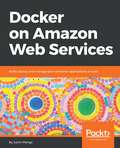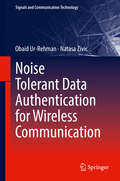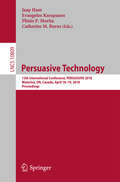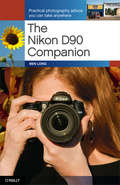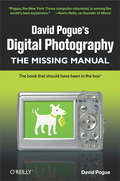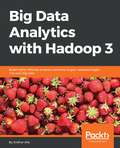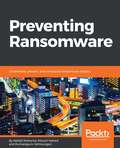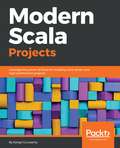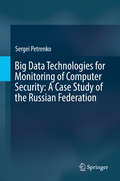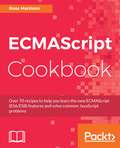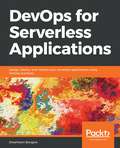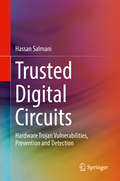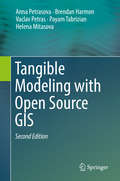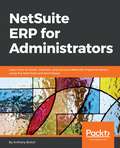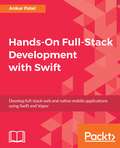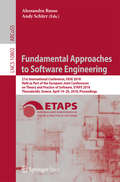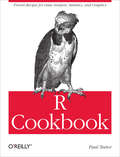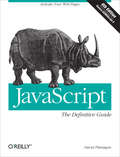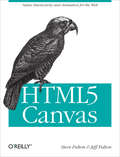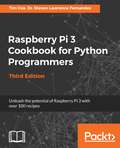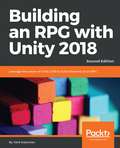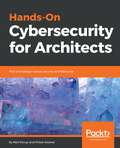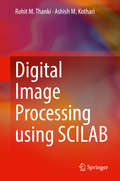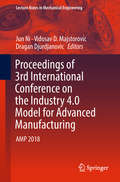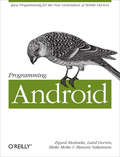- Table View
- List View
Docker on Amazon Web Services: Build, deploy, and manage your container applications at scale
by Justin MengaRun Docker on AWS and build real-world, secure, and scalable container platforms on cloudKey FeaturesConfigure Docker for the ECS environmentIntegrate Docker with different AWS toolsImplement container networking and deployment at scaleBook DescriptionOver the last few years, Docker has been the gold standard for building and distributing container applications. Amazon Web Services (AWS) is a leader in public cloud computing, and was the first to offer a managed container platform in the form of the Elastic Container Service (ECS).Docker on Amazon Web Services starts with the basics of containers, Docker, and AWS, before teaching you how to install Docker on your local machine and establish access to your AWS account. You'll then dig deeper into the ECS, a native container management platform provided by AWS that simplifies management and operation of your Docker clusters and applications for no additional cost. Once you have got to grips with the basics, you'll solve key operational challenges, including secrets management and auto-scaling your infrastructure and applications. You'll explore alternative strategies for deploying and running your Docker applications on AWS, including Fargate and ECS Service Discovery, Elastic Beanstalk, Docker Swarm and Elastic Kubernetes Service (EKS). In addition to this, there will be a strong focus on adopting an Infrastructure as Code (IaC) approach using AWS CloudFormation.By the end of this book, you'll not only understand how to run Docker on AWS, but also be able to build real-world, secure, and scalable container platforms in the cloud.What you will learnBuild, deploy, and operate Docker applications using AWSSolve key operational challenges, such as secrets managementExploit the powerful capabilities and tight integration of other AWS servicesDesign and operate Docker applications running on ECSDeploy Docker applications quickly, consistently, and reliably using IaCManage and operate Docker clusters and applications for no additional costWho this book is forDocker on Amazon Web Services is for you if you want to build, deploy, and operate applications using the power of containers, Docker, and Amazon Web Services. Basic understanding of containers and Amazon Web Services or any other cloud provider will be helpful, although no previous experience of working with these is required.
Noise Tolerant Data Authentication for Wireless Communication (Signals And Communication Technology)
by Obaid Ur-Rehman Natasa ZivicThis book provides insight into the challenges in providing data authentication over wireless communication channels. The authors posit that established standard authentication mechanisms – for wired devices – are not sufficient to authenticate data, such as voice, images, and video over wireless channels. The authors propose new mechanisms based on the so-called soft authentication algorithms, which tolerate some legitimate modifications in the data that they protect. The authors explain that the goal of these algorithms is that they are tolerant to changes in the content but are still able to identify the forgeries. The authors go on to describe how an additional advantage of the soft authentication algorithms is the ability to identify the locations of the modifications and correct them if possible. The authors show how to achieve this by protecting the data features with the help of error correcting codes. The correction methods are typically based on watermarking, as the authors discuss in the book.Provides a discussion of data (particularly image) authentication methods in the presence of noise experienced in wireless communication;Presents a new class of soft authentication methods, instead of the standard hard authentication methods, used to tolerate minor changes in image data;Features authentication methods based on the usage of authentication tags as well as digital watermarks.
Persuasive Technology: 13th International Conference, Persuasive 2018, Waterloo, On, Canada, April 18-19, 2018, Proceedings (Lecture Notes in Computer Science #10809)
by Jaap Ham Evangelos Karapanos Plinio P. Morita Catherine M. BurnsThis book constitutes the refereed proceedings of the 13th International Conference on Persuasive Technology, PERSUASIVE 2018, held in Waterloo, ON, Canada, in April 2018. The 21 revised full papers and 4 short papers presented were carefully reviewed and selected from 59 submissions. The papers demonstrate how persuasive technologies can help solve societal issues. They explore new frontiers for persuasive technology, such as personalized persuasion, new sensor usage, uses of big data, and new ways of creating engagement through gaming or social connection, focusing on a variety of technologies (e.g., web, wearables, AI, and smart environments). The papers are organized in the following topical sections: social means to persuasion; nudging and just-in-time interventions; design principles and practices; persuasive games; personalization and tailoring; and theoretical reflections.
The Nikon D90 Companion: Practical Photography Advice You Can Take Anywhere
by Ben LongThrough easy-to-follow lessons, this handy book offers a complete class on digital photography, tailored specifically for people who use the Nikon D90. This is not your typical camera guide: rather than just show you what all the buttons do, it teaches you how to use the D90's features to make great photographs-including professional-looking images of people, landscapes, action shots, close-ups, night shots, HD video, and more. With Ben Long's creative tips and technical advice, you have the perfect, camera-bag-friendly reference that will help you capture stunning pictures anywhere, anytime. The Nikon D90 Companion will show you how to: Take creative control and go beyond automatic settings Learn the basic rules of composition Capture decisive moments, including fast-moving objects Discover ways to use a flash indoors and outdoors Learn about different lenses, and the best time to use them Understand the options for shooting RAW, and whether it's right for you Use the D90's ability to shoot high definition video
David Pogue's Digital Photography: The Missing Manual (Missing Manual)
by David PogueIf you're ready to jump into digital photography or would like to increase the skills you already have, David Pogue's Digital Photography: The Missing Manual is just what you need. Bestselling author David Pogue provides a no-nonsense guide to the entire process, including how to: buy and use a digital camera; get the same photographic effects as the pros; manage the results on your Mac or PC; edit photos; and, finally, share the results with your adoring fans -- on paper, online, or on mugs, jigsaw puzzles, and blankets. After reviewing hundreds of digital cameras and photo services in his weekly New York Times column, David Pogue knows digital photography. With this new Missing Manual you will:Get expert advice on how to choose a digital camera, including information on the only specs that matter. (Hint: it's not about megapixels). Learn the basics of lighting, composition, and shooting lots of photos Understand how to choose the best camera settings for 20 different scenarios Unravel the problems of correcting images and storing them Learn David's tips and tricks for sharing and printing images Get a special troubleshooting section you can turn to when things go wrong David Pogue's witty, authoritative voice has demystified the Mac, Windows, iPods and iPhones for millions of readers. Now, he offers step-by-step instructions and plenty of friendly advice to help you join in the fun and get real satisfaction from digital photography.
Big Data Analytics with Hadoop 3: Build highly effective analytics solutions to gain valuable insight into your big data
by Sridhar AllaExplore big data concepts, platforms, analytics, and their applications using the power of Hadoop 3Key FeaturesLearn Hadoop 3 to build effective big data analytics solutions on-premise and on cloudIntegrate Hadoop with other big data tools such as R, Python, Apache Spark, and Apache FlinkExploit big data using Hadoop 3 with real-world examplesBook DescriptionApache Hadoop is the most popular platform for big data processing, and can be combined with a host of other big data tools to build powerful analytics solutions. Big Data Analytics with Hadoop 3 shows you how to do just that, by providing insights into the software as well as its benefits with the help of practical examples.Once you have taken a tour of Hadoop 3’s latest features, you will get an overview of HDFS, MapReduce, and YARN, and how they enable faster, more efficient big data processing. You will then move on to learning how to integrate Hadoop with the open source tools, such as Python and R, to analyze and visualize data and perform statistical computing on big data. As you get acquainted with all this, you will explore how to use Hadoop 3 with Apache Spark and Apache Flink for real-time data analytics and stream processing. In addition to this, you will understand how to use Hadoop to build analytics solutions on the cloud and an end-to-end pipeline to perform big data analysis using practical use cases.By the end of this book, you will be well-versed with the analytical capabilities of the Hadoop ecosystem. You will be able to build powerful solutions to perform big data analytics and get insight effortlessly.What you will learnExplore the new features of Hadoop 3 along with HDFS, YARN, and MapReduceGet well-versed with the analytical capabilities of Hadoop ecosystem using practical examplesIntegrate Hadoop with R and Python for more efficient big data processing Learn to use Hadoop with Apache Spark and Apache Flink for real-time data analyticsSet up a Hadoop cluster on AWS cloudPerform big data analytics on AWS using Elastic Map ReduceWho this book is forBig Data Analytics with Hadoop 3 is for you if you are looking to build high-performance analytics solutions for your enterprise or business using Hadoop 3’s powerful features, or you’re new to big data analytics. A basic understanding of the Java programming language is required.
Preventing Ransomware: Understand, prevent, and remediate ransomware attacks
by Abhijit Mohanta Kumaraguru Velmurugan Mounir HahadYour one-stop guide to know digital extortion and it's prevention.Key FeaturesA complete guide to how ransomware worksBuild a security mechanism to prevent digital extortion.A practical approach to knowing about, and responding to, ransomware.Book DescriptionRansomware has turned out to be the most aggressive malware and has affected numerous organizations in the recent past. The current need is to have a defensive mechanism in place for workstations and servers under one organization.This book starts by explaining the basics of malware, specifically ransomware. The book provides some quick tips on malware analysis and how you can identify different kinds of malware. We will also take a look at different types of ransomware, and how it reaches your system, spreads in your organization, and hijacks your computer. We will then move on to how the ransom is paid and the negative effects of doing so. You will learn how to respond quickly to ransomware attacks and how to protect yourself. The book gives a brief overview of the internals of security software and Windows features that can be helpful in ransomware prevention for administrators. You will also look at practical use cases in each stage of the ransomware phenomenon. The book talks in detail about the latest ransomware attacks involving WannaCry, Petya, and BadRabbit.By the end of this book, you will have end-to-end knowledge of the trending malware in the tech industry at present.What you will learn Understand malware types and malware techniques with examples Obtain a quick malware analysis Understand ransomware techniques, their distribution, and their payment mechanism Case studies of famous ransomware attacks Discover detection technologies for complex malware and ransomware Configure security software to protect against ransomware Handle ransomware infectionsWho this book is forThis book is targeted towards security administrator, security analysts, or any stakeholders in the security sector who want to learn about the most trending malware in the current market: ransomware.
Modern Scala Projects: Leverage the power of Scala for building data-driven and high-performant projects
by Ilango GurusamyDevelop robust, Scala-powered projects with the help of machine learning libraries such as SparkML to harvest meaningful insightKey FeaturesGain hands-on experience in building data science projects with Scala Exploit powerful functionalities of machine learning librariesUse machine learning algorithms and decision tree models for enterprise appsBook DescriptionScala, together with the Spark Framework, forms a rich and powerful data processing ecosystem. Modern Scala Projects is a journey into the depths of this ecosystem. The machine learning (ML) projects presented in this book enable you to create practical, robust data analytics solutions, with an emphasis on automating data workflows with the Spark ML pipeline API. This book showcases or carefully cherry-picks from Scala’s functional libraries and other constructs to help readers roll out their own scalable data processing frameworks. The projects in this book enable data practitioners across all industries gain insights into data that will help organizations have strategic and competitive advantage. Modern Scala Projects focuses on the application of supervisory learning ML techniques that classify data and make predictions. You'll begin with working on a project to predict a class of flower by implementing a simple machine learning model. Next, you'll create a cancer diagnosis classification pipeline, followed by projects delving into stock price prediction, spam filtering, fraud detection, and a recommendation engine. By the end of this book, you will be able to build efficient data science projects that fulfil your software requirements.What you will learnCreate pipelines to extract data or analytics and visualizationsAutomate your process pipeline with jobs that are reproducible Extract intelligent data efficiently from large, disparate datasets Automate the extraction, transformation, and loading of dataDevelop tools that collate, model, and analyze dataMaintain the integrity of data as data flows become more complexDevelop tools that predict outcomes based on “pattern discovery”Build really fast and accurate machine-learning models in ScalaWho this book is forModern Scala Projects is for Scala developers who would like to gain some hands-on experience with some interesting real-world projects. Prior programming experience with Scala is necessary.
Big Data Technologies for Monitoring of Computer Security: A Case Study of the Russian Federation
by Sergei PetrenkoThis timely book offers rare insight into the field of cybersecurity in Russia -- a significant player with regard to cyber-attacks and cyber war. Big Data Technologies for Monitoring of Computer Security presents possible solutions to the relatively new scientific/technical problem of developing an early-warning cybersecurity system for critically important governmental information assets. Using the work being done in Russia on new information security systems as a case study, the book shares valuable insights gained during the process of designing and constructing open segment prototypes of this system. Most books on cybersecurity focus solely on the technical aspects. But Big Data Technologies for Monitoring of Computer Security demonstrates that military and political considerations should be included as well. With a broad market including architects and research engineers in the field of information security, as well as managers of corporate and state structures, including Chief Information Officers of domestic automation services (CIO) and chief information security officers (CISO), this book can also be used as a case study in university courses.
ECMAScript Cookbook: Over 70 recipes to help you learn the new ECMAScript (ES6/ES8) features and solve common JavaScript problems
by Ross HarrisonBecome a better web programmer by writing efficient and modular code using ES6 and ES8Key FeaturesLearn to write asynchronous code and improve the readability of your web applications Explore advanced concepts such as closures, Proxy, generators, Promise, async functions, and Atomics Use different design patterns to create structures to solve common organizational and processing issuesBook DescriptionECMAScript Cookbook follows a modular approach with independent recipes covering different feature sets and specifications of ECMAScript to help you become an efficient programmer.This book starts off with organizing your JavaScript applications as well as delivering those applications to modem and legacy systems. You will get acquainted with features of ECMAScript 8 such as async, SharedArrayBuffers, and Atomic operations that enhance asynchronous and parallel operations. In addition to this, this book will introduce you to SharedArrayBuffers, which allow web workers to share data directly, and Atomic operations, which help coordinate behavior across the threads. You will also work with OOP and Collections, followed by new functions and methods on the built-in Object and Array types that make common operations more manageable and less error-prone. You will then see how to easily build more sophisticated and expressive program structures with classes and inheritance. In the end, we will cover Sets, Maps, and Symbols, which are the new types introduced in ECMAScript 6 to add new behaviors and allow you to create simple and powerful modules.By the end of the book, you will be able to produce more efficient, expressive, and simpler programs using the new features of ECMAScript. What you will learnOrganize JavaScript programs across multiple files, using ES modulesCreate and work with promises using the Promise object and methodsCompose async functions to propagate and handle errorsSolve organizational and processing issues with structures using design patternsUse classes to encapsulate and share behaviorOrchestrate parallel programs using WebWorkers, SharedMemory, and AtomicsUse and extend Map, Set, and Symbol to work with user-defined classes and simulate data typesExplore new array methods to avoid looping with arrays and other collectionsWho this book is forIf you’re a web developer with a basic understanding of JavaScript and wish to learn the latest features of ECMAScript for developing efficient web applications, this book is for you.
DevOps for Serverless Applications: Design, deploy, and monitor your serverless applications using DevOps practices
by Shashikant BangeraSet up complete CI and CD pipelines for your serverless applications using DevOps principlesKey FeaturesUnderstand various services for designing serverless architecture Build CD pipelines using various cloud providers for your serverless applications Implement DevOps best practices when building serverless applicationsBook DescriptionServerless applications are becoming very popular among developers and are generating a buzz in the tech market. Many organizations struggle with the effective implementation of DevOps with serverless applications. DevOps for Serverless Applications takes you through different DevOps-related scenarios to give you a solid foundation in serverless deployment.You will start by understanding the concepts of serverless architecture and development, and why they are important. Then, you will get to grips with the DevOps ideology and gain an understanding of how it fits into the Serverless Framework. You'll cover deployment framework building and deployment with CI and CD pipelines for serverless applications. You will also explore log management and issue reporting in the serverless environment. In the concluding chapters, you will learn important security tips and best practices for secure pipeline management.By the end of this book, you will be in a position to effectively build a complete CI and CD delivery pipeline with log management for serverless applications.What you will learnExplore serverless fundamentals and effectively combine them with DevOpsSet up CI and CD with AWS Lambda and other popular Serverless service providers with the help of the Serverless FrameworkPerform monitoring and logging with serverless applicationsSet up a dynamic dashboard for different service providersDiscover best practices for applying DevOps to serverless architectureUnderstand use cases for different serverless architecturesWho this book is forDevOps for Serverless Applications is for DevOps engineers, architects, or anyone interested in understanding the DevOps ideology in the serverless world. You will learn to use DevOps with serverless and apply continuous integration, continuous delivery, testing, logging, and monitoring with serverless.
Trusted Digital Circuits: Hardware Trojan Vulnerabilities, Prevention And Detection
by Hassan SalmaniThis book describes the integrated circuit supply chain flow and discusses security issues across the flow, which can undermine the trustworthiness of final design. The author discusses and analyzes the complexity of the flow, along with vulnerabilities of digital circuits to malicious modifications (i.e. hardware Trojans) at the register-transfer level, gate level and layout level. Various metrics are discussed to quantify circuit vulnerabilities to hardware Trojans at different levels. Readers are introduced to design techniques for preventing hardware Trojan insertion and to facilitate hardware Trojan detection. Trusted testing is also discussed, enabling design trustworthiness at different steps of the integrated circuit design flow. Coverage also includes hardware Trojans in mixed-signal circuits.
Tangible Modeling with Open Source GIS
by Helena Mitasova Anna Petrasova Brendan Harmon Vaclav Petras Payam TabrizianThis book provides an overview of the latest developments in the fast growing field of tangible user interfaces. It presents a new type of modeling environment where the users interact with geospatial data and simulations using 3D physical landscape model coupled with 3D rendering engine. Multiple users can modify the physical model, while it is being scanned, providing input for geospatial analysis and simulations. The results are then visualized by projecting images or animations back on the physical model while photorealistic renderings of human views are displayed on a computer screen or in a virtual reality headset. New techniques and software which couple the hardware set-up with open source GRASS GIS and Blender rendering engine, make the system instantly applicable to a wide range of applications in geoscience education, landscape design, computer games, stakeholder engagement, and many others. This second edition introduces a new more powerful version of the tangible modeling environment with multiple types of interaction, including polymeric sand molding, placement of markers, and delineation of areas using colored felt patches. Chapters on coupling tangible interaction with 3D rendering engine and immersive virtual environment, and a case study integrating the tools presented throughout this book, demonstrate the second generation of the system - Immersive Tangible Landscape - that enhances the modeling and design process through interactive rendering of modeled landscape. This book explains main components of Immersive Tangible Landscape System, and provides the basic workflows for running the applications. The fundamentals of the system are followed by series of example applications in geomorphometry, hydrology, coastal and fluvial flooding, fire spread, landscape and park design, solar energy, trail planning, and others. Graduate and undergraduate students and educators in geospatial science, earth science, landscape architecture, computer graphics and games, natural resources and many others disciplines, will find this book useful as a reference or secondary textbook. Researchers who want to build and further develop the system will most likely be the core audience, but also anybody interested in geospatial modeling applications (hazard risk management, hydrology, solar energy, coastal and fluvial flooding, fire spread, landscape and park design) will want to purchase this book.
NetSuite ERP for Administrators: Learn how to install, maintain, and secure a NetSuite implementation, using the best tools and techniques
by Anthony BickofLearn steps and tasks to help a NetSuite administrator perform both his daily and monthly tasks efficiently. Advance his expertise to become NetSuite leader without having to spend time and money on corporate trainings.Key FeaturesUnderstand the business considerations and implementation of the NetSuite ERPGain a deep knowledge of enterprise security, data management, process automation, and analyticsLearn techniques to sail through system maintenance while ensuring accuracy and to practically troubleshoot issuesBook DescriptionNetSuite ERP is a complete, scalable cloud ERP solution targeted at fast-growing, mid-sized businesses and large enterprises. It's the smartly executed combination of financial management operations and built-in business intelligence, which enables companies to make data-driven and well-informed decisions. This book will help administrators become expert enough to be seen as the NetSuite leader at their company and to be able to advise department heads on specific processes, and strategic decisions. We start with an overview of ERP and NetSuite ERP, before going on to explain the built-in features to show the breadth of NetSuite ERP's product and its ease of use. We then discuss business aspects, focusing on the most important processes in NetSuite. Then you'll understand the implementation aspects that are generic enough to cover all the features. The focus then shifts to specific skills that you will need to administer for any system, such as roles, permissions, customization, and data imports. Moving on, you'll learn how to centralize the creation of search templates and give users the tools to pivot the data and expose it to the user in useful ways, such as on the dashboard. The book ends with checklists providing actionable steps that you as an administrator can take to do your job and support the application through new releases and troubleshooting problems.What you will learn Provide executives with meaningful insights into the business A Framework to streamline the implementation of new and existing features Leverage built-in tools to optimize your efficiency and effectiveness Test configuration to check the implementation of role-specific permissions Understand how to optimize the amount of data to be shared with users Import data like new leads and employ current data like pricing updates Perform on-going maintenance and troubleshoot issuesWho this book is forThis book is for administrators, consultants, and Project Managers who would like to improve their skills in the areas of configuration and system management. Basic experience implementing NetSuite is assumed.
Hands-On Full-Stack Development with Swift: Develop full-stack web and native mobile applications using Swift and Vapor
by Ankur PatelBuild full-stack shopping list applications from scratch for web and mobile platforms using Xcode, Vapor, and SwiftKey FeaturesBuild, package, and deploy an end-to-end app solution for mobile and web with Swift 4Increase developer productivity by creating reusable client and server componentsDevelop backend services for your apps and websites using Vapor frameworkBook DescriptionMaking Swift an open-source language enabled it to share code between a native app and a server. Building a scalable and secure server backend opens up new possibilities, such as building an entire application written in one language—Swift.This book gives you a detailed walk-through of tasks such as developing a native shopping list app with Swift and creating a full-stack backend using Vapor (which serves as an API server for the mobile app). You'll also discover how to build a web server to support dynamic web pages in browsers, thereby creating a rich application experience.You’ll begin by planning and then building a native iOS app using Swift. Then, you'll get to grips with building web pages and creating web views of your native app using Vapor. To put things into perspective, you'll learn how to build an entire full-stack web application and an API server for your native mobile app, followed by learning how to deploy the app to the cloud, and add registration and authentication to it.Once you get acquainted with creating applications, you'll build a tvOS version of the shopping list app and explore how easy is it to create an app for a different platform with maximum code shareability. Towards the end, you’ll also learn how to create an entire app for different platforms in Swift, thus enhancing your productivity.What you will learnGet accustomed to server-side programming as well as the Vapor frameworkLearn how to build a RESTful APIMake network requests from your app and handle error states when a network request failsDeploy your app to Heroku using the CLI commandWrite a test for the Vapor backendCreate a tvOS version of your shopping list app and explore code-sharing with an iOS platformAdd registration and authentication so that users can have their own shopping listsWho this book is forThis book is for developers who are looking to build full-stack web and native mobile applications using Swift. An understanding of HTML, CSS, and JavaScript would be beneficial when building server-rendered pages with Vapor.
Fundamental Approaches to Software Engineering: 21st International Conference, Fase 2018, Held As Part Of The European Joint Conferences On Theory And Practice Of Software, Etaps 2018, Thessaloniki, Greece, April 14-20, 2018, Proceedings (Lecture Notes in Computer Science #10802)
by Alessandra Russo Andy SchürrThis book is Open Access under a CC BY licence.This book constitutes the proceedings of the 21st International Conference on Fundamental Approaches to Software Engineering, FASE 2018, which took place in Thessaloniki, Greece in April 2018, held as Part of the European Joint Conferences on Theory and Practice of Software, ETAPS 2018.The 19 papers presented in this volume were carefully reviewed and selected from 63 submissions. The papers are organized in topical sections named: model-based software development; distributed program and system analysis; software design and verification; specification and program testing; family-based software development.
R Cookbook: Proven Recipes for Data Analysis, Statistics, and Graphics (Cookbook Ser.)
by Paul TeetorWith more than 200 practical recipes, this book helps you perform data analysis with R quickly and efficiently. The R language provides everything you need to do statistical work, but its structure can be difficult to master. This collection of concise, task-oriented recipes makes you productive with R immediately, with solutions ranging from basic tasks to input and output, general statistics, graphics, and linear regression. Each recipe addresses a specific problem, with a discussion that explains the solution and offers insight into how it works. If you're a beginner, R Cookbook will help get you started. If you're an experienced data programmer, it will jog your memory and expand your horizons. You'll get the job done faster and learn more about R in the process. Create vectors, handle variables, and perform other basic functions Input and output data Tackle data structures such as matrices, lists, factors, and data frames Work with probability, probability distributions, and random variables Calculate statistics and confidence intervals, and perform statistical tests Create a variety of graphic displays Build statistical models with linear regressions and analysis of variance (ANOVA) Explore advanced statistical techniques, such as finding clusters in your data "Wonderfully readable, R Cookbook serves not only as a solutions manual of sorts, but as a truly enjoyable way to explore the R language--one practical example at a time." --Jeffrey Ryan, software consultant and R package author
JavaScript: Activate Your Web Pages
by David FlanaganSince 1996, JavaScript: The Definitive Guide has been the bible for JavaScript programmers--a programmer's guide and comprehensive reference to the core language and to the client-side JavaScript APIs defined by web browsers. The 6th edition covers HTML5 and ECMAScript 5. Many chapters have been completely rewritten to bring them in line with today's best web development practices. New chapters in this edition document jQuery and server side JavaScript. It's recommended for experienced programmers who want to learn the programming language of the Web, and for current JavaScript programmers who want to master it. "A must-have reference for expert JavaScript programmers...well-organized and detailed." --Brendan Eich, creator of JavaScript, CTO of Mozilla "I made a career of what I learned from JavaScript: The Definitive Guide." -- Andrew Hedges, Tapulouso client-side JavaScript, including legacy web browser APIs, the standard Level 2 DOM API, the XMLHttpRequest object, and the canvas tag "A must-have reference for expert JavaScript programmers...well-organized and detailed." --Brendan Eich, creator of JavaScript, CTO of Mozilla "I made a career of what I learned from JavaScript: The Definitive Guide." -- Andrew Hedges, Tapulous "The Definitive Guide taught me JavaScript." --Tom Robinson, co-founder of 280 North, co-creator of Cappuccino
HTML5 Canvas: For Games And Entertainment
by Steve Fulton Jeff FultonNo matter what platform or tools you use, the HTML5 revolution will soon change the way you build web applications, if it hasn't already. HTML5 is jam-packed with features, and there's a lot to learn. This book gets you started with the Canvas element, perhaps HTML5's most exciting feature. Learn how to build interactive multimedia applications using this element to draw, render text, manipulate images, and create animation. Whether you currently use Flash, Silverlight, or just HTML and JavaScript, you'll quickly pick up the basics. Practical examples show you how to create various games and entertainment applications with Canvas as you learn. Gain valuable experience with HTML5, and discover why leading application developers rave about this specification as the future of truly innovative web development. Create and modify 2D drawings, text, and bitmap images Incorporate and manipulate video, and add audio Build a basic framework for creating a variety of games on Canvas Use bitmaps and tile sheets to develop animated game graphics Go mobile: port Canvas applications to iPhone with PhoneGap Explore ways to use Canvas for 3D and multiplayer game applications
Raspberry Pi 3 Cookbook for Python Programmers: Unleash the potential of Raspberry Pi 3 with over 100 recipes, 3rd Edition
by Dr Steven FernandesA recipe-based guide to programming your Raspberry Pi 3 using PythonKey FeaturesLeverage the power of Raspberry Pi 3 using Python programmingCreate 3D games, build neural network modules, and interface with your own circuitsPacked with clear, step-by-step recipes to walk you through the capabilities of Raspberry PiBook DescriptionRaspberry Pi 3 Cookbook for Python Programmers – Third Edition begins by guiding you through setting up Raspberry Pi 3, performing tasks using Python 3.6, and introducing the first steps to interface with electronics. As you work through each chapter, you will build your skills and apply them as you progress. You will learn how to build text classifiers, predict sentiments in words, develop applications using the popular Tkinter library, and create games by controlling graphics on your screen. You will harness the power of a built in graphics processor using Pi3D to generate your own high-quality 3D graphics and environments.You will understand how to connect Raspberry Pi’s hardware pins directly to control electronics, from switching on LEDs and responding to push buttons to driving motors and servos. Get to grips with monitoring sensors to gather real-life data, using it to control other devices, and viewing the results over the internet. You will apply what you have learned by creating your own Pi-Rover or Pi-Hexipod robots. You will also learn about sentiment analysis, face recognition techniques, and building neural network modules for optical character recognition.Finally, you will learn to build movie recommendations system on Raspberry Pi 3.What you will learnLearn to set up and run Raspberry Pi 3Build text classifiers and perform automation using PythonPredict sentiments in words and create games and graphicsDetect edges and contours in imagesBuild human face detection and recognition systemUse Python to drive hardwareSense and display real-world dataBuild a neural network module for optical character recognitionBuild movie recommendations systemWho this book is forThis book is for anyone who wants to master the skills of Python programming using Raspberry Pi 3. Prior knowledge of Python will be an added advantage.
Building an RPG with Unity 2018: Leverage the power of Unity 2018 to build elements of an RPG., 2nd Edition
by Vahé KaramianBuild a high-end, multiplayer role-playing game (RPG) from scratch with C# and Unity 2018Key FeaturesGet insights into Unity's user interface (UI) system and and build UIs for your RPGImplement artificial intelligence (AI) to build intelligent entities that take your game to the next levelDevelop multiplayer features for an RPG using Unity 2018Book DescriptionIn a role-playing game (RPG), users control a character, usually in the game's imaginary universe. Unity has become a top choice for developers looking to create these kinds of immersive RPGs.Building an RPG with Unity 2018, based on building some of the most common RPG features, teaches you tips, tricks, and techniques that can be applied to your own game.To start with, the book guides you through the fundamentals of role-playing games. You will learn the necessary aspects of building an RPG, such as structuring the game environment, customizing characters, controlling the camera, and designing other attributes such as inventory and weapons. You will also explore designing game levels by adding more features. Once you have understood the bigger picture, you will understand how to tackle the obstacles of networking in Unity and implement multiplayer mode for your RPG games.By the end of the book, you will be able to build upon the core RPG framework elements to create your own immersive games.What you will learnConstruct a framework for inventory, equipment, characters, enemies, quests, and game eventsUnderstand how to load and unload scenes and assetsCreate multiplayer game settings for your RPGDesign a UI for user input and feedbackImplement AI for non-character playersCustomize your character at runtimeWho this book is forBuilding an RPG with Unity 2018 is for you if you are a programmer interested in developing and further enhancing your skills when developing RPGs in Unity 2018. This book does not cover the basics of Unity, and so is for intermediate or more advanced users.
Hands-On Cybersecurity for Architects: Plan and design robust security architectures
by Neil Rerup Milad AslanerGain practical experience of creating security solutions and designing secure, highly available, and dynamic infrastructure for your organizationKey FeaturesArchitect complex security structures using standard practices and use casesIntegrate security with any architecture solutionImplement cybersecurity architecture in various enterprisesBook DescriptionSolutions in the IT domain have been undergoing massive changes. There was a time when bringing your own devices to work was like committing a crime. However, with an evolving IT industry comes emerging security approaches.Hands-On Cybersecurity for Architects will help you to successfully design, integrate, and implement complex security structures in any solution whilst ensuring that the solution functions as expected. To start with, you will get to grips with the fundamentals of recent cybersecurity practices, followed by acquiring and understanding your organization's requirements. You will then move on to learning how to plan and design robust security architectures, along with practical approaches to performing various security assessments. Once you have grasped all this, you will learn to design and develop key requirements, such as firewalls, virtual private networks (VPNs), wide area networks (WANs), and digital certifications. In addition to this, you will discover how to integrate upcoming security changes on Bring your own device (BYOD), cloud platforms, and the Internet of Things (IoT), among others. Finally, you will explore how to design frequent updates and upgrades for your systems as per your enterprise's needs.By the end of this book, you will be able to architect solutions with robust security components for your infrastructure.What you will learnUnderstand different security architecture layers and their integration with all solutionsStudy SWOT analysis and dig into your organization’s requirements to drive the strategyDesign and implement a secure email service approachMonitor the age and capacity of security tools and architectureExplore growth projections and architecture strategyIdentify trends, as well as what a security architect should take into considerationWho this book is forHands-On Cybersecurity for Architects is for you if you are a security, network, or system administrator interested in taking on more complex responsibilities such as designing and implementing complex security structures. Basic understanding of network and computer security implementation will be helpful. This book is also ideal for non-security architects who want to understand how to integrate security into their solutions.
Digital Image Processing using SCILAB
by Rohit M. Thanki Ashish M. KothariThis book provides basic theories and implementations using SCILAB open-source software for digital images. The book simplifies image processing theories and well as implementation of image processing algorithms, making it accessible to those with basic knowledge of image processing. This book includes many SCILAB programs at the end of each theory, which help in understanding concepts. The book includes more than sixty SCILAB programs of the image processing theory. In the appendix, readers will find a deeper glimpse into the research areas in the image processing.
Proceedings of 3rd International Conference on the Industry 4.0 Model for Advanced Manufacturing: Amp 2018 (Lecture Notes In Mechanical Engineering)
by Jun Ni Vidosav D. Majstorovic Dragan DjurdjanovicThis book presents the proceedings of the 3rd International Conference on the Industry 4.0 Model for Advanced Manufacturing (AMP 2018), held in Belgrade, Serbia, on 5–7 June 2018, the latest in a series of high-level conferences that brings together experts from academia and industry to exchange knowledge, ideas, experiences, research findings, and information in the field of manufacturing. The book addresses a wide range of topics, including, for example, design of smart and intelligent products, developments in CAD/CAM technologies, rapid prototyping and reverse engineering, multistage manufacturing processes, manufacturing automation in the Industry 4.0 model, cloud-based products, and cyber-physical and reconfigurable manufacturing systems. By providing updates on key issues and recent advances in manufacturing engineering and technologies, it aids the transfer of vital knowledge to the next generation of academics and practitioners. It appeals to anyone working or conducting research in this rapidly evolving field.
Programming Android: Java Programming For The New Generation Of Mobile Devices
by G. Blake Meike Zigurd Mednieks Laird Dornin Masumi NakamuraWhat does it take to build well-engineered Android applications? Explore Android's core building blocks and APIs in depth with this authoritative guide, and learn how to create compelling apps that work on a full range of Android devices. You'll work with proven approaches to app design and implementation—including application frameworks that you can use as a starting point for your own projects.Delve into sensors, native development, 3D graphics, and many other topics, and discover how to build apps on the platform of your choice. If you're an intermediate to advanced programmer, you'll learn how to make great Android apps.Learn how to use the Android SDK with the Eclipse IDEApply advanced Java concepts regardless of your experience with the languageCreate an Android user interface that's captivating and easy to navigateUse the Fragment API for tablet user interfacesMake your application compatible with Honeycomb and earlier versionsUnderstand Android's unique database design issues and the role of SQLiteUse sensors and gestures to expand your app's input beyond just tapping and scrollingExplore Android APIs for multimedia, location, communication, NFC, and other applications
